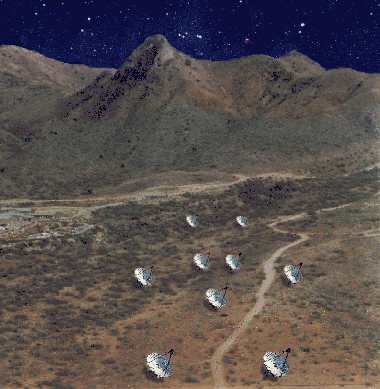
6.3 GROUND BASED
Many ground-based "third-generation" atmospheric Cherenkov systems are now under consideration which will have sensitivity in the 10 - 100 GeV energy range. The energy threshold varies inversely as the product of the square root of the total mirror area, the light collection efficiency and the quantum efficiency of the detectors. Hence if a threshold of 200 GeV can be achieved with a 10m aperture reflector, then a threshold of 20 GeV is feasible with a reflector with an effective aperture of 100m. In practice an array of detectors offers better background rejection and more economical construction than a single reflector. One such approach is VERITAS (Very Energetic Radiation Imaging Telescope Array System); this is a logical development of the imaging atmospheric Cherenkov concept and consists of an array of nine telescopes of 10m aperture each closely based on the proven design of the Whipple 10m optical reflector. This array would easily reach a threshold of 50 GeV with conventional photomultipliers; with advanced technology detectors it could be as low as 30 GeV. Its flux sensitivity for discrete sources would be very competitive with planned high-energy gamma-ray space missions i.e., 2x10-12 photons cm-2 s-1 at 100 GeV. It would also have excellent spectral resolution.

Figure 6.1 - This artist's conception of the proposed VERITAS instrument
is one example of the future direction of ground-based gamma-ray astronomy.
The VERITAS approach is not unique among atmospheric Cherenkov observatories
proposed as a next generation system although it is probably the most conservative
and predictable. Other approaches include a large, steerable, single dish
(17 m aperture) with a high resolution camera, the Solar Array approach
whereby existing arrays of heliostats (built as solar energy collectors)
are utilized as large area light collectors with a central detector, and
the Arecibo concept in which a single fixed optical dish is located at
very high mountain altitude and imaged unto an array of some 10,000 photomultipliers.
Mention should also be made of large water Cherenkov systems e.g., MILAGRO
which are most useful as burst monitors and for all-sky surveys. Developments
in space-and ground-based detector technology have an obvious impact on
one another; ground-based detectors will rely on space missions for selection
of suitable sources and for all-sky monitoring of source activity. In return,
ground-based observation can supply improved spatial localization, high-energy
spectrum measurements and high count statistics to probe short-time variability.
It is clearly advantageous in the planning of future missions/telescopes
that the development of the overlapping techniques proceed in parallel.
Ground-based observatories will continue to operate after the demise of
EGRET and will thus provide continuity in the field; they can be continually
upgraded to achieve maximum sensitivity at the launch of an EGRET successor.